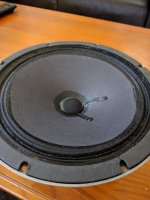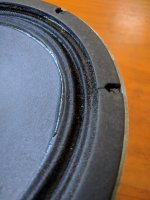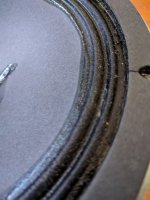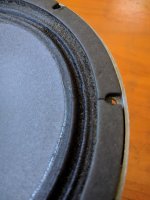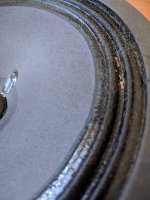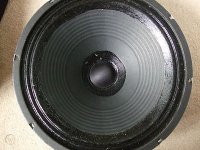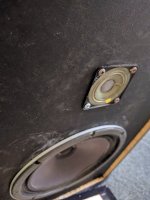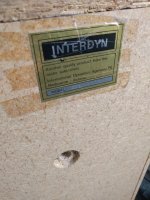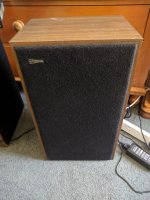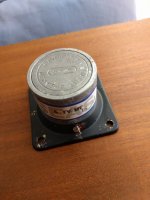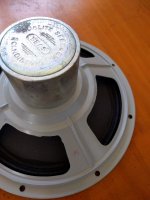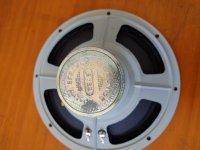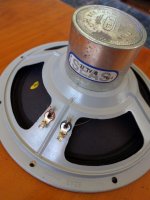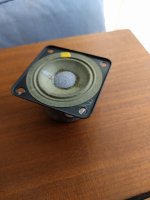Hi All.
The foam surrounds finally arrived for my SEAS Woofer repair work.
The old surrounds appear have hardened a little and appear breached in one or two places.
The cone material appears to be paper.
I really would prefer to keep them as original as possible.
Is there:
1. A preparation which, when applied can make the old surround more flexible? and
2. A glue which can be used to patch any breaches in the surround?
Many thanks
Cliff
The foam surrounds finally arrived for my SEAS Woofer repair work.
The old surrounds appear have hardened a little and appear breached in one or two places.
The cone material appears to be paper.
I really would prefer to keep them as original as possible.
Is there:
1. A preparation which, when applied can make the old surround more flexible? and
2. A glue which can be used to patch any breaches in the surround?
Many thanks
Cliff
Last edited:
Which SEAS drivers were they again?
The possibility of rejuvenation depends on the exact material from which the original surrounds are made - do you know?
Some photos showing the extent of the patching which is required would be most valuable.
The possibility of rejuvenation depends on the exact material from which the original surrounds are made - do you know?
Some photos showing the extent of the patching which is required would be most valuable.
Last edited:
I don't understand why you want to repair old enveloping if new ones have arrived.
They will never work well again, they are already broken. Point
They will never work well again, they are already broken. Point
I think Cliff is worried that changing rubber to foam will change the characteristics of the driver.
Given his subjects, I would simply replace with foam and be damned! 😉
Given his subjects, I would simply replace with foam and be damned! 😉
In a previous thread no less! 🙂Ah, that explains it, but are you a fortune teller? Where does it say ?
At least, I thought so, but I've looked and can't locate the pertinent thread.
Apologies if I've confused Cliff with another member.
Apologies if I've confused Cliff with another member.
The one who forgot to give the complete information is the OP, anyway congratulations on your memory .....
The elasticity of the new foam shell can be compensated for with several applications (layers) of liquid silicone to achieve rubber-like compliance.
The closest thing to a successful solution that I see is that, and measure the resonance of an already repaired speaker with the least damaged, until achieving a similar approximation
The elasticity of the new foam shell can be compensated for with several applications (layers) of liquid silicone to achieve rubber-like compliance.
The closest thing to a successful solution that I see is that, and measure the resonance of an already repaired speaker with the least damaged, until achieving a similar approximation
Sorry for the tardy response.
So many projects.
The drivers with rubber surrounds were the CTS's belonging to another project.
The Loudspeakers for this thread are a pair of Interdyns using SEAS drivers.
I don't know what the material is that's used.
Maybe someone can identify it via the pictures I've posted.
The existing surrounds are bordering on being brittle and I think porous in places. They look like someone has doped them in the past.
The main reasoning for saving them is to attempt to keep these old speakers as original as possible without compromising sound.
I have the new foam surrounds and will use them if this is the correct path.
Until input from the members, I'm not enlightened in respect to refurbishing with as little replacement as possible.
So many projects.
The drivers with rubber surrounds were the CTS's belonging to another project.
The Loudspeakers for this thread are a pair of Interdyns using SEAS drivers.
I don't know what the material is that's used.
Maybe someone can identify it via the pictures I've posted.
The existing surrounds are bordering on being brittle and I think porous in places. They look like someone has doped them in the past.
The main reasoning for saving them is to attempt to keep these old speakers as original as possible without compromising sound.
I have the new foam surrounds and will use them if this is the correct path.
Until input from the members, I'm not enlightened in respect to refurbishing with as little replacement as possible.
Attachments
This looks like a doped corrugated paper, or possibly fabric, surround.
If so, it will not be as compliant as a rubber or foam surround and will be stiffer in its action.
I can't see any damage overall. Are the brown spots in the final picture holes, or simply areas where the dopant has worn off?
Any gaps in the doped suround may be filled with a the likes of Copydex latex adhesive.
I would NOT replace the surround on current evidence.
Why no details of the model of the driver? That would help. As would details of the Interdyne in which it is mounted.
If so, it will not be as compliant as a rubber or foam surround and will be stiffer in its action.
I can't see any damage overall. Are the brown spots in the final picture holes, or simply areas where the dopant has worn off?
Any gaps in the doped suround may be filled with a the likes of Copydex latex adhesive.
I would NOT replace the surround on current evidence.
Why no details of the model of the driver? That would help. As would details of the Interdyne in which it is mounted.
Corrugated surrounds are also called 'pleated' or 'accordian pleated' surrounds.
The paper corrugations have to be thin to be flexible enough to allow cone movement.
The dope provides protection for the thin surround and extends its life while still keeping it flexible.
It also allows the speaker to handle higher power without the thin surround splitting.
The paper corrugations have to be thin to be flexible enough to allow cone movement.
The dope provides protection for the thin surround and extends its life while still keeping it flexible.
It also allows the speaker to handle higher power without the thin surround splitting.
Attachments
This looks like a doped corrugated paper, or possibly fabric, surround.
If so, it will not be as compliant as a rubber or foam surround and will be stiffer in its action.
I can't see any damage overall. Are the brown spots in the final picture holes, or simply areas where the dopant has worn off?
Any gaps in the doped suround may be filled with a the likes of Copydex latex adhesive.
I would NOT replace the surround on current evidence.
Why no details of the model of the driver? That would help. As would details of the Interdyne in which it is mounted.
Hi G.
The Loudspeakers are Interdyn Model 212
These were made in Australia using SEAS drivers.
A 2 x Way design with 3.3mf Capacitor.
Woofer:
SEAS 21T/-G 76-=12
210mm wide metal basket
Tweeter
SEAS 5 TV.HE 76-18
35mm paper dome tweeter
The brown spots look like hardened dope.
If you look carefully there are a couple of breaches.
I'd describe it as very fine porosity.
From your comments I might try another coat of doping to seal any possible leakage.
Copydex doesn't appear to be readily available cheaply in Australia.
Can I use Mod Podge instead?
Attachments
Last edited:
A quick search brings up SEAS 21TV-G drivers, aka Blackcones: BLACKCONES
Mod Podge should be OK. You may have to thin it with water so that you can brush it on. I would try it on a small area first to see the result when it dries. You want it to dry flexible and adhere to the original doping material. At least it will not harm the original volatile solvent based doping material.
If not identical to your driver, it is obviously very similar.The vintage SEAS 21TV-G is a low-ohmic, high sensitivity driver, fitted with a lightweight paper cone driven by a 1" voice coil. The surround is a corrugated extension of the paper cone and coated with some sticky goo. This "goo", coating material, is probably the most consistent coating ever made as its elasticity appears unchanged over decades.
Mod Podge should be OK. You may have to thin it with water so that you can brush it on. I would try it on a small area first to see the result when it dries. You want it to dry flexible and adhere to the original doping material. At least it will not harm the original volatile solvent based doping material.
I found 4 nice images of the Interdyn 212 here:
Vintage Interdyn Model 212 Hi-Fi Speakers | Speakers | Gumtree Australia Burnie Area - Upper Burnie | 1265935178
Could they be yours, Cliff?
Vintage Interdyn Model 212 Hi-Fi Speakers | Speakers | Gumtree Australia Burnie Area - Upper Burnie | 1265935178
Could they be yours, Cliff?
Thanks Galu.
A nice example.
I hope that price doesn't reflect their worth. 😱
Shipping costs can tip Loudspeakers towards the wrong side of a bargain.
And the possibility that there maybe few audiophiles living in Burnie.
Here are mine at their current state.
Wiring and Poly Cap upgrade has been done.
I'll dope the surrounds and reassemble soon, then give them a listen. 🙂
A nice example.
I hope that price doesn't reflect their worth. 😱
Shipping costs can tip Loudspeakers towards the wrong side of a bargain.
And the possibility that there maybe few audiophiles living in Burnie.
Here are mine at their current state.
Wiring and Poly Cap upgrade has been done.
I'll dope the surrounds and reassemble soon, then give them a listen. 🙂
Attachments
Any chance of a picture showing the rear of your driver before you screw it back into the enclosure?
You've got some nice vintage drivers there, and they may be sought after by those seeking high sensitivity drivers, like those with low wattage SET amplifiers.
The mid-bass drivers are clearly labelled 21 TV G, so they are the 'BLACKCONES' to which I linked earlier. They have 96dB sensitivity, 4 ohm nominal impedance and resonance frequency 50-60Hz. Full details are in the link I gave you. Note, in particular, that they have a low power rating of only 8W, but they will go very loud with just 1W of input. So, take it easy with your amplifier volume setting.
If they are in good working condition, I would NOT mess around with them at all.
I would not attempt to 're-dope' the mid/bass driver's surrounds except for sealing up any obvious holes or tears - none of which I can see on your earlier photographs - although they do become blurred when I zoom in.
The cabinet looks to be of sound construction. What absorbent material was used in the sealed enclosure?
The mid-bass drivers are clearly labelled 21 TV G, so they are the 'BLACKCONES' to which I linked earlier. They have 96dB sensitivity, 4 ohm nominal impedance and resonance frequency 50-60Hz. Full details are in the link I gave you. Note, in particular, that they have a low power rating of only 8W, but they will go very loud with just 1W of input. So, take it easy with your amplifier volume setting.
If they are in good working condition, I would NOT mess around with them at all.
I would not attempt to 're-dope' the mid/bass driver's surrounds except for sealing up any obvious holes or tears - none of which I can see on your earlier photographs - although they do become blurred when I zoom in.
The cabinet looks to be of sound construction. What absorbent material was used in the sealed enclosure?
Just in case you missed it in post #14, here is the link which gives all the details of your 21 TV G drivers: BLACKCONES
- Home
- Design & Build
- Construction Tips
- Rejuvenate old SEAS Drivers?
